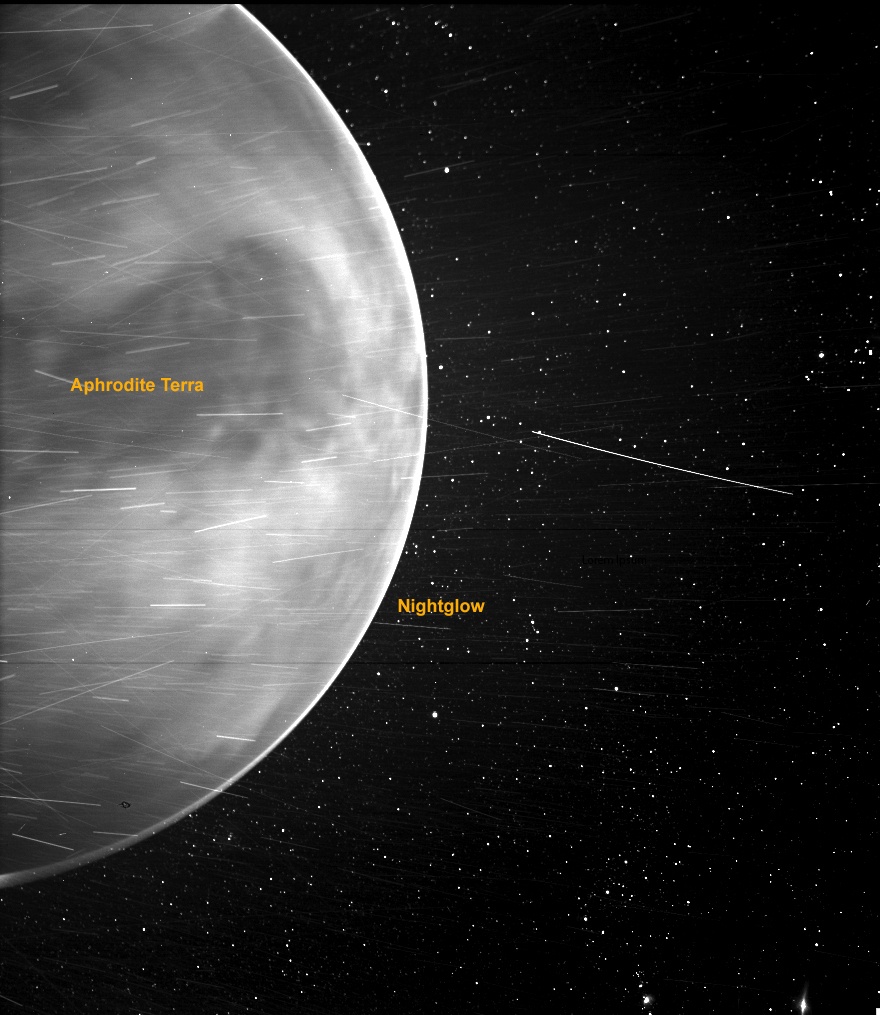Parker Solar Probe Captured Images of Venus on its way to the Sun
By Nancy Atkinson
Last summer, the Parker Solar Probe flew past Venus on its way to fly closer to the Sun. In a bit of a surprise, one of the spacecraft’s cameras, the Wide-field Imager for Parker Solar Probe, or WISPR, captured a striking image of the planet’s nightside from 7,693 miles (12380 km) away.
The surprise of the image was that WISPR – a visible light camera – seemingly captured the Venus’ surface in infrared light.
Mission scientists expected WISPR to capture Venus’ thick, carbon dioxide clouds, which normally block views of the surface. But instead, the camera was able see through the clouds, revealing the dark-tinted shape of Aphrodite Terra, a highland area near Venus’ equator. The feature appears dark because of its lower temperature, about 85 degrees Fahrenheit (30 degrees Celsius) cooler than its surroundings.
“WISPR is tailored and tested for visible light observations,” said Angelos Vourlidas, the WISPR project scientist. “We expected to see clouds, but the camera peered right through to the surface.”
While the Parker Solar Probe’s focus is the Sun, NASA says that Venus plays a critical role in the mission. The spacecraft whizzes past Venus a total of seven times over the course of its seven-year mission, and uses the planet for a gravity assist. This allows the spacecraft to fly closer and closer to the Sun.
The flyby in July 2020 was the third of the seven gravity assists.

Credits: NASA/Johns Hopkins APL/Naval Research Laboratory/Guillermo Stenborg and Brendan Gallagher
“WISPR effectively captured the thermal emission of the Venusian surface,” said Brian Wood, an astrophysicist and WISPR scientist at the US Naval Research Laboratory in Washington, DC. Wood added that the image was similar to those taken by Japan’s Akatsuki spacecraft, which is currently studying Venus, and includes cameras that can capture light at near-infrared wavelengths.
The bright streaks in the image are typically caused by a combination of charged particles — called cosmic rays — and sunlight reflected by grains of space dust, and particles of material expelled from the spacecraft’s structures after impact with those dust grains. The number of streaks varies along the orbit or when the spacecraft is traveling at different speeds, and scientists are still in discussion about the specific origins of the streaks here.
Here’s a look at a “cleaned up” version by imaging enthusiast (and former UT writer) Jason Major:
WISPR is designed to take images of the solar corona and inner heliosphere in visible light, as well as images of the solar wind and its structures as they approach and fly by the spacecraft. At Venus, the camera detected a bright rim around the edge of the planet that may be nightglow — light emitted by oxygen atoms high in the atmosphere that recombine into molecules in the nightside.
This surprise observation sent the WISPR team back to the lab to measure the instrument’s sensitivity to infrared light.

If WISPR it indeed can see in infrared, it could provide an unexpected new way for the mission to study dust circling the Sun. To test it out, he WISPR team planned a set of similar observations of the Venusian nightside during Parker Solar Probe’s latest Venus flyby – which just occurred on Feb. 20, 2021. Mission team scientists expect to receive and process that data for analysis by the end of April.
But if the appearance of Aphrodite Terra was a type of “fluke,” it could mean WISPR discovered a previously unknown opening in the thick Venusian clouds, providing a fleeting window that showed portions of the planet’s surface.
“Either way,” Vourlidas said, “some exciting science opportunities await us.”
Source: NASA
The post Parker Solar Probe Captured Images of Venus on its way to the Sun appeared first on Universe Today.

March 1, 2021 at 02:49AM
via Universe Today read more...

Post a Comment